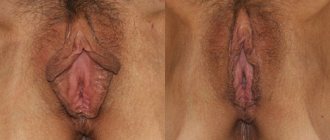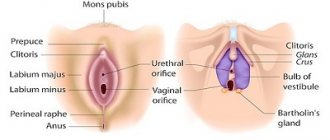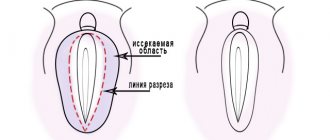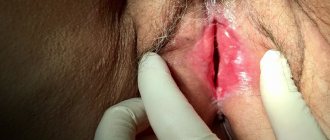Hypertrophy of the labia minora is their excessive protrusion beyond the labia majora. With lateral extension, their length exceeds 4-5 cm. This phenomenon is not pathological and does not pose a threat to women’s health, except perhaps psychologically. This is, rather, a cosmetic defect, and even then within the framework of individual criteria of beauty and sexuality. However, correction of the labia minora is one of the most common operations in the field of aesthetic surgery related to the genitals.
Causes
Hypertrophy of the labia minora can be caused by both congenital, constitutional characteristics and acquired changes. Hypertrophy of the labia minora often occurs in premature girls and children with low birth weight. Genetically determined hypertrophy of the labia minora usually becomes apparent during puberty or with the onset of sexual activity. Hypertrophy can further intensify or develop as a result of mechanical irritation or stretching of the labia minora during sexual intercourse or childbirth, chronic vulvitis, vulvar lymphedema, sudden weight loss, etc. The shape and size of the labia minora can be affected by trauma or surgery on the vulva, infatuation piercing of intimate areas. With age, the labia minora undergo age-related involution, wrinkle, and change color.
Hypertrophy of the labia minora
Medical staff assure that the outer size of the labia can be up to 5 cm. If the length of the outer labia is 6 cm or more, then surgical intervention is necessary. With the fourth degree of hypertrophy of the labia minora, the organ not only increases in size, but also becomes more wrinkled and folded. Often a severe form of the disease leads to sexual hyposthesia of the vulva. But women have always strived to be more beautiful, so for most, stretching the labia minora to 1 cm is the norm.
Classification
Based on aesthetic ideas, there are four degrees of hypertrophy of the labia minora:
- first degree. The external labia protrude 1-2 cm;
- second degree. Lengthening of the external labia minora within 2-4 cm, such a deformation already causes the woman some discomfort when walking. Problems arise with hygiene procedures;
- third degree. The external labia minora are stretched by 2-4 cm, and the woman feels discomfort when walking, riding a bicycle, and even when sitting on a chair;
- fourth degree. The external labia minora are increased in size by more than 6 cm and the woman experiences chronic irritation in the genital area. Difficulties arise with certain movements, the girl’s life is filled with dissatisfaction and complexes.
Medical specialists distinguish three types of deviations from the anatomically accepted norm:
- deviations in the general shape of the labia minora (asymmetry, equal edges of the external labia minora);
- deviations in the size of the labia (enlargement, lengthening, complete absence of the external labia);
- deviations associated with the nature of the surface of the labia minora (excessive pigmentation, formation of folds, presence of scars).
But the main problem for women is still aesthetic appearance. With excessive enlargement of the labia minora, a woman can no longer wear beautiful underwear; she feels insecure, tight, dissatisfied, and multiple complexes develop. Women with this problem not only have difficulties in their sex life, they also cannot sunbathe and swim freely. Any place where a swimsuit is required becomes off-limits.
Operation restrictions
Girls under eighteen years of age cannot undergo surgery to change the condition of the labia. Correction is not recommended for people with cancer. Contraindications to genital surgery are nonspecific vaginitis and infectious diseases that are transmitted through sexual contact. People who have mental disorders should not undergo surgery.
Preparation for the procedure
Before the operation, the patient is carefully examined. The woman is taken from blood tests and checked for AIDS, syphilis and hepatitis B and C. A special gynecological examination is carried out to assess the condition of the outer and inner labia, and a gynecological smear is taken for flora. A woman should definitely be examined by a dermatologist to confirm that she definitely does not have any skin inflammatory processes. The endocrinologist must also check the woman’s condition and if all is well, then they do final tests of electrocardiography, coagulogram and tests for sensitivity to anesthesia.
How is surgery performed?
Correction of the labia is usually performed under local anesthesia. At the client's request, the operation can be performed under general anesthesia. Correction of the labia takes from two to four hours.
Postoperative period
During the first time after correction, the woman feels pain in the genital area. After a few days, the swelling subsides and the patient’s condition improves. In a month you will be able to return to sexual activity and thermal procedures. For several months it is better not to do strenuous exercise and not to lift weights. The labia acquire a beautiful aesthetic shape only a few months after correction.
Possible complications
Correction of the labia can have unpleasant consequences, since in any operation there is a possibility of negative consequences. As postoperative complications, scars, scars, hematomas and heavy bleeding may occur. The labia may lose sensation and never again be an erogenous zone. After surgery, there is a risk of inflammation and infections. But negative consequences, as statistics say, do not occur often; in general, the woman’s condition after the operation is good. Ninety percent of women are satisfied with the results of correction of the labia, their lives change only for the better.
Plastic surgery of the labia minora and majora is becoming increasingly popular among women. And every year the gynecological plastic surgery market is developing more and more.
Women have always been and will be interested in their appearance, and especially the aesthetic state of their intimate parts. A big leap in the development of intimate plastic surgery occurred at the beginning of the nineteenth century, when the demand for such procedures increased. In our century, there are a huge number of clinics that perform all possible operations in the genital area. Millions of plastic and gynecological specialists take part in international forums. There they exchange knowledge, experience, share scientific discoveries and introduce innovations. Soon, operations to correct the labia will become widely popular, such as hair removal in the bikini area and removal of unwanted hair.
Symptoms
Despite the fact that hypertrophy of the labia minora is not a medical disease, it can greatly complicate a woman’s life. Patients' complaints can be divided into three groups: psychological, aesthetic, functional. Psychological problems caused by hypertrophy of the labia minora consist of intimate problems. So, a woman considers herself unattractive, so she tries to avoid sexual intercourse, cannot experience orgasm, and feels constrained during sex. The aesthetic component lies in dissatisfaction with the appearance of one’s naked body. Some ladies refuse to go to the beach, swimming pool, massage rooms, saunas, baths, that is, places where they need to change clothes. Functional complaints consist of physical discomfort. For example, a woman cannot engage in certain sports, experiences discomfort while wearing tight-fitting underwear or trousers, complains of discomfort while walking, running, feels pain during sexual intercourse, has difficulty performing personal hygiene, and during a gynecological examination. Due to constant mechanical friction, the labia minora can become inflamed, lose tone, become flabby, and their pigmentation may change, which only aggravates the situation.
Psychological problems with enlarged long labia minora
Any girl or woman has many psychological problems and complexes associated with too long labia minora. Such women withdraw into themselves and are embarrassed to have sex. Do not wear transparent dresses or panties. Do not wear revealing swimsuits or minibikinis. They don’t go to massages, baths, saunas, or water parks.
Thus, enlarged labia minora are often anatomical features of your female body.
Functional problems include pain or soreness during sex.
The beautiful labia minora are completely covered by the labia majora and never protrude beyond the labia majora.
If you have scalloped edges of the labia minora, elongation, loss of tone, hypotrophy, hypertrophy, folding, scarring, elongation, sagging, thickening, enlargement of the labia minora, change in color, consistency, odor of vaginal discharge, itchy clitoris, sore pubis, dryness vagina, frigidity, lack of orgasm, vaginismus, you need to see a doctor.
Diagnosis and treatment
Diagnosis is made during a routine gynecological examination. The decision to eliminate hypertrophy of the labia minora is made by the woman herself, based on her own criteria of beauty and attractiveness. Surgical correction of hypertrophy of the labia minora is one of the most common areas of female genital plastic surgery. There are two main methods of performing surgery on the labia minora. The first and oldest technique involves linear resection of the protruding parts of the labia minora. This method has its advantages and disadvantages - the advantages include the simplicity and functionality of the operation, and the disadvantages include a certain unnatural straightness of the appearance of the labia minora, since after resection of the protruding parts their natural shape and folding changes. To avoid the artificial feeling, another method of truncation of the labia minora (wedge resection of the labia minora) was developed, which involves cutting out V-shaped flaps on each side. With this operation, the natural appearance of the labia minora is preserved, and the size is reduced.
Diagnosis of vulvitis
To diagnose vulvitis, in most cases, a simple manual examination by a doctor is sufficient, as well as taking a smear for bacteriological, bacterioscopic and cytological examination. The results obtained allow us not only to determine the presence of inflammation, but also to exclude malignant tumors and identify the causative agent of the infection. Additionally, the doctor may prescribe a stool test to detect helminthiasis.
Appointment with a doctor for the treatment of vulvitis
A detailed description of the symptoms and the initial stage of the disease will also have diagnostic value for the doctor. This will simplify the diagnosis and make it possible to exclude any concomitant infections. After all, the itching that vulvitis causes leads (especially often in girls) to the appearance of scratching in the area of the external genitalia, which may also indicate the presence of diseases such as pediculosis, dermatitis or lichen. Also, the cause of itching in the labia area can be any sexually transmitted disease, which sometimes may require consultation with a dermatovenerologist or additional diagnostics.
Surgical treatment
Treatment can only mean surgical correction of overgrown tissues of the external female intimate organs. This is explained by the fact that any other treatment methods are simply unable to bring any obvious and lasting results. The reasons for prescribing surgical intervention are considered to be:
- Unaesthetic appearance of the external intimate organs, associated with the growth of the labia minora by more than 5 centimeters.
- The third and fourth stages of development of the disease bring the patient significant physical discomfort, which has a negative impact on her quality of life, physiological and emotional state.
In the presence of advanced stages of the disease, the risk of damage to the external genital organs during active physical exercise, sexual activity, or during childbirth increases significantly. To avoid all the problems listed above, the attending gynecologist can refer a patient with an overgrowth of the lower intimate lips for surgical treatment.
Plastic surgery of the labia, aimed at correcting their size, will relieve the girl of all problems associated with the growth of external intimate organs. Surgical intervention is performed by excision of the overgrown area of the labia, which is performed using a laser or scalpel.
These manipulations are performed under local anesthesia or sedation. The patient may be offered anesthesia in the form of injection or application of a special anesthetic cream to the site of surgical adjustment. After removing the overgrown labia, sutures made of easily absorbable modern medical threads will be placed on the surface of the external intimate organ. Typically, the operation time ranges from 30 minutes to one hour.
Clinical picture
Stretched labia minora (from 5 cm or more in the maximum stretched state) contribute to a decrease in a woman’s erectility and sensitivity during intimacy. In this case, they are visible from under the large ones, although normally this should not be the case.
Stretched labia majora often appear wrinkled and protrude unsightly when wearing tight-fitting trousers or jeans and underwear (camel toe effect). In addition, if their lower commissure is deformed, a gaping of the genital gap occurs. This in turn leads to recurrent infections of the vagina, urethra and bladder.
Rehabilitation process
How effective the surgical intervention will be directly depends on whether the entire range of additional procedures is carried out during the recovery period. In most cases, rehabilitation after labiaplasty includes the following therapeutic and restorative measures:
- daily douching with antiseptic drugs;
- applying wound healing preparations to the sutures that are specially designed for the care of postoperative sutures;
- a ten-day course of antibiotics prescribed by your doctor.
- In addition, to avoid damage to the operated epithelium and possible bleeding, the girl should take care to:
- For 2 - 3 weeks, sit less and avoid wearing tight-fitting underwear;
- Avoid any damage to the external genitalia,
- Avoid hot water treatments and sunbathing for 2 or 3 weeks;
- Avoid swimming in public pools and natural bodies of water for a month;
- Avoid intimacy and masturbation for a month;
- Postpone sports activities for 3 weeks.
Experience shows that if all the listed tips and recommendations are followed, healing in the operated area occurs quickly and without complications.
Treatment of vulvitis
If you notice any alarming symptoms, you should immediately consult a doctor. Only a specialist can diagnose the cause and prescribe correct and quick treatment, including a set of measures: relieving inflammation, eliminating factors that are catalysts for the process.
The basis of treatment for vulvitis is the elimination of the causes of the inflammatory process and treatment of concomitant diseases, which may include diabetes mellitus (Diabetes mellītus), gonorrhea (Gonorrhoea), diphtheria (Diphtheria), helminthiasis. After receiving smear test data and checking the sensitivity of the infectious agent, the doctor can prescribe medication, most often antibacterial drugs. Vulvitis responds well to treatment with local remedies, which include all kinds of ointments, gels and suppositories.
In parallel, in the course of treatment of vaginitis, vitamin complexes can be prescribed, including vitamin A to effectively protect the epithelial layer, as well as vitamins E and C, known for their antioxidant properties.
To combat severe symptoms, other drugs may be prescribed:
- Antihistamines that help relieve itching.
- Hormonal, occurring in atrophic vulvitis in the postmenopausal period.
- Anesthetics that relieve pain.
In addition to the medications prescribed by your doctor, you can use Gynocomfort Restoring Gel. This product was created by specialists from the pharmaceutical company VERTEX and underwent clinical trials at the Department of Dermatovenerology with the clinic of the St. Petersburg State Medical University. During testing of the gel, it was proven that it is a very effective additional agent as part of the complex therapy of inflammatory processes of the female genital tract.
As additional therapeutic measures that can be used at home, it is worth mentioning warm baths with herbal infusion.
Chamomile, calendula, string, and comfrey have excellent anti-inflammatory properties.
Baths will help not only reduce inflammation, but also relieve symptoms such as itching, burning and pain.










